Eventful September in Baranja - Over 15,000 Visitors Expected
August 24, 2022 - The Biggest Croatian Fish Stew Day, Fishing Days, Wine Marathon, and World Fishing Championship. September in Baranja looks eventful. Over 15,000 visitors are expected.
As Glas Slavonije writes, since the beginning of the year, more than 13,000 tourists visited Baranja, accounting for approximately 23,000 overnight stays.
The results are significantly better than last year, reaching the level of the record 2019. A real tidal wave of arrivals and overnight stays is expected during September when several events will be held in Baranja that have recently become famous outside of the county borders.
“Judging by the announcements, we expect about 15,000 visitors at the September events alone, mostly domestic, but with a respectable number of foreign visitors as well”, said Matej Perkušić, director of the Baranja Tourist Board, stressing that this should be felt in the occupancy of accommodation capacities throughout Baranja, but also in Osijek and its surroundings. It all starts with the Biggest Croatian Fish Stew Festival, which will take place in Beli Manastir on September 3. It is a "two in one" competition - the Croatian Championship, for the winners of the Slavonia-Baranja competition, and the amateur championship, for everyone else. In total, more than 200 chefs are expected.
“About 70 amateur chefs have applied so far, and we expect the majority of applications a day or two before the deadline, which is in less than a week”, said Perkušić. Along with several interesting games, the bands TS Žeteoci and Magazin will be in charge of entertainment.
The middle of September is reserved for another established Baranja event, Fishing Days in Kopačevo. Ten thousand visitors were there last year, and as many are expected this year as well.
“Last year, because of the pandemic, we decided that Fishing Days would be a three-day event, and it turned out to be a complete success. Therefore, this year they will be held on Friday, Saturday, and Sunday (September 16 - 18)”, said Željko Cickaj, mayor of Bilje Municipality, pointing out that visitors can expect between four and five tons of fish, to which the "gastro programs" must be added, organised alongside with the central part. In addition to local delicacies, guests will also be able to enjoy a cultural and entertainment program. On Friday, after the official opening, the band Gazde will play, followed by TS Kvinta in the tent. Saturday is reserved for The Garden, klapa Rišpet, and TS Nesanica (in the tent), and on Sunday there will be a traditional fish stew cook-off, several traditional music, and dance ensembles, and TS Sitan Vez will perform.
“Although this year there is a problem with acquiring the needed quantities, the members of the hunting club from Kopačevo started their preparations on time, so there will be enough fish” Cickaj pointed out.
And on the last weekend of September (Friday and Saturday), all roads will lead to Zmajevac, to its mountain paths and wine cellars.
“We expect that approximately 2,500 marathoners will “run” the marathon this year, possibly more. Applications started back in February. For example, the team from Hungary that participated in the marathon last year had six members. This year, they expanded the team to 73 members, for both days” on behalf of the organizer, the Surduk Association, said Kristijan Horvat. This year, the partner countries will be Hungary and North Macedonia. An interesting entertainment program awaits visitors. Although the dice are still “coming together”, Frajle, Hungarian violinist Nyari Bernardett, and Macedonian artist Tijana Dabčević will perform together on Friday. The arrival of Tamara Tadevska, who defended the Macedonian colours at the Eurovision Song Contest, is also planned. Concerts on two stages are planned for Saturday.
How good is your knowledge of eastern Croatia? Take the CROMADS test above - how many places do you recognise?
For more, make sure to check out our dedicated Travel section.
Contents of a Slavonian Easter Basket: From Eggs to Green Onions
15th of April 2022 - The most important Christian holiday is almost here which means plenty of food and traditions that have been part of Croatian culture for centuries are in focus. A look at the contents of a Slavonian Easter basket.
With Lent being over on Palm Sunday, Holy Week and the final days before Easter have begun. Of course, that means believers who participated in relinquishing and fasting during Lent can finally start eating normally, except on Good Friday when fasting is strictly prescribed. Preparations for Easter include a lot of cooking and preparing sweet pastries to celebrate Jesus’s resurrection. Good Thursday is dedicated to the remembrance of Christ’s Last dinner and no one can work on their soils or crops. As already mentioned, Good Friday includes a strict fast with only one proper meal allowed, which symbolizes Jesus’s torment and death. After Good Friday, Good Saturday is reserved for silence and preparations of said meals that have everything from heavy meat to spring vegetables and more. However, the most important part of the Easter celebration is definitely an Easter basket, which contains a variety of foods reserved for blessing and later for Easter celebration, most commonly as a breakfast on Easter itself.
Easter Eggs
Most things in the basket are definitely Easter eggs (pisanice), or boiled chicken eggs with beautiful handmade designs that differ from family to family. This custom of decorating and gifting eggs was known throughout Europe, especially among Germans, Scandinavians, and Slavs. Even its age is confirmed by archeological grave finds. When it comes to Christianity, the egg is a symbol of the new and eternal life that Jesus made possible for people through the resurrection. In Croatian traditional culture, the custom has remained to this day. In the past, only domestic homemade colors were used for painting eggs and they were obtained from broccoli, onion peel, nettle, various grasses, and many more. Aniline dyes became popular much later. Wax was applied to the egg by a special funnel-shaped pen or pinhead; this technique also made it possible to obtain multicolored ornament. These traditional ways of painting Easter eggs came back - more and more people fall back to old customs because of healthy and more organic ways of painting. On Easter morning, eggs are put to use - children break eggs to determine who has the strongest one.
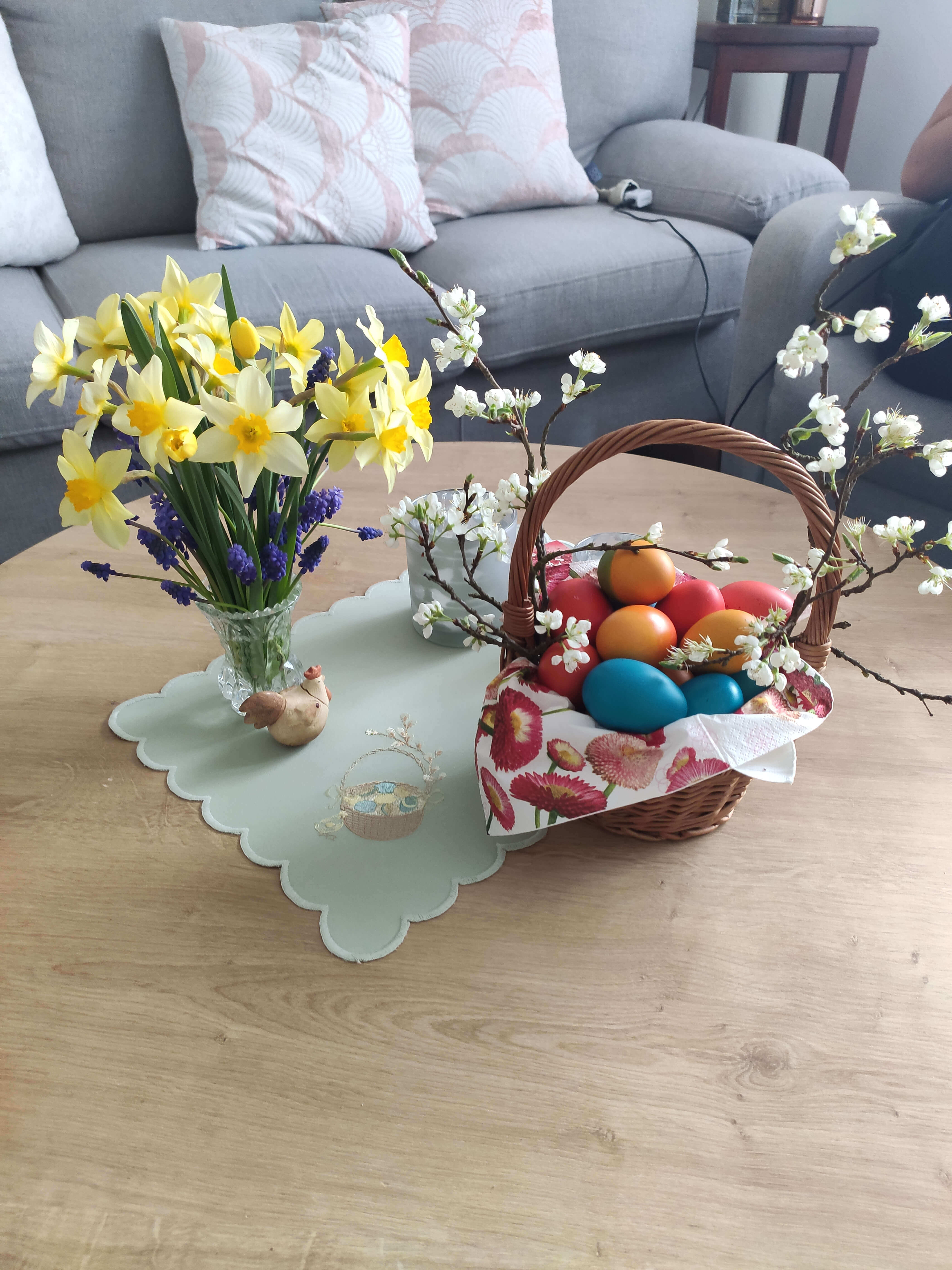
Colored Easter eggs and spring flowers on Easter (photo credit: Private album)
Unleavened bread
As we know a lot of Christian traditions are shared with Jewish customs and unleavened bread is part of that as well. It symbolizes Christ’s body and according to Bible, was present at Christ’s Last dinner. There are a lot of variations of bread throughout Croatia like normal pogača, pinca, however, unleavened bread is a customary Easter bread in Slavonia and represents sacrifice. Its texture is somewhere between hard and soft and has a neutral flavor which fits amazingly well with other Easter basket components.
If you’re interested in making this bread, here is my family’s recipe that’s been used every Easter for decades:
0,5 kg of smooth flour
1 package of baking powder
1 teaspoon of salt
4 egg yolks
1 egg
1 tablespoon of pork lard
10 dag of butter
Method:
Mix with milk so that it is neither soft nor hard. Let it sit for 10 minutes, after that put it in a small bowl with a diameter of 18 cm. Grease the bread really well with lard and put the bread in the oven preheated to 180°C. Bake it for 30 minutes, take it out, coat it with egg yolk and milk mixture using a brush, put it back in the oven, reduce the temperature to 150°C and bake it for 25 minutes more.
There you go! You have a proper Slavonian bread that’s part of every Easter basket.

Easter breakfast with food from Easter basket (photo credit: Private album)
Ham
Fragrant-cooked ham is certainly the main star of the Easter table and what evaluates the quality of its preparation is juiciness. The type of meat is really important but the best is definitely pork meat or rather pork leg which is considered the “real” ham. Other than classic cooked ham that we know and love, there is an alternative - ham wrapped in pastry. Again, its preparation varies from family to family and the quality of the meat is determined by the financial status of the people who prepare it.
If you’re interested in the preparation of cooked Easter ham, check this recipe here.
Radish
The so-called spring queen of health and a vitamin bomb. Although radish is primarily associated with the Easter table, many people buy this vegetable because of its rich nutritional composition and medicinal properties. Indispensable food of every Slavonian Easter basket.
Green onion
If it's planted before Spring, green or young onions are definitely an unavoidable vegetable for the Easter basket. Strong, spicy, and its intensive smell with ham bring something really special to every Slavonian household on Easter. Like radish, it is a great ingredient in a variety of Easter salads.
Sweet cakes and pastries
Last but not least, cakes and pastries are a must in every Slavonian Easter basket. From usual pies like cakes like mađarica, chocolate pie, white pie, honey pie, so-called Katherine (Katarina kolač), and coconut-walnut cubes that were and still are a staple for Slavonian desserts through decades, small cakes, pastries, and cookies are getting more and more popular in recent years. Likes of išleri, baskets (košarice), rum balls, linzers, triangles and so many more. Cherry or apricot strudel is also a recent pastry baked and consumed on Easter. Breskvice (peaches) as well - signature Slavonian cake.
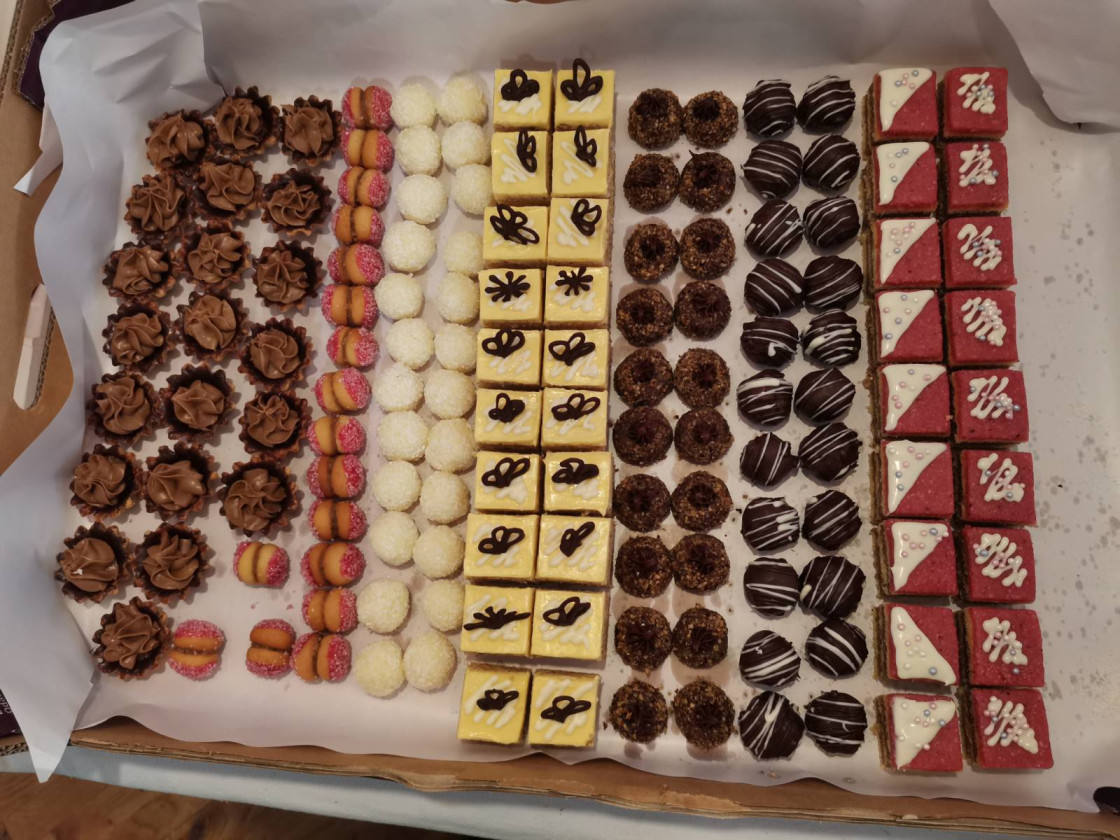
Sweet cakes and popular pies in Slavonia (photo credit: Private album)
Salt is also part of the blessed Easter basket with candles that will be lit on Easter breakfast and other various items that believers want to bless.
As said in the beginning, Easter is the most important Christian holiday. It celebrates Christ’s sacrifice and resurrection. Throughout the centuries, Croatians managed to save huge parts of their cultural and traditional heritage and it’s not a coincidence that Easter customs are one of the oldest traditional practices in Croatia’s history. It doesn’t matter if you’re not a believer, everyone is welcome to try the contents of a Slavonian Easter basket, take it, and in the end, try to make these delicious meals for themselves. At the end of the day, this is the time, not just for sacrifice, but for sharing and love as well.
Sretan Uskrs!
For more about lifestyle in Croatia, visit our dedicated TCN page.
Traditional Festivities in Slavonia - Unmissable Events
7th of April 2022 - There are a lot of festivities you can visit in Slavonia - from beer and food festivals that became really popular in recent years, to modernized cultural manifestations which teach us something new. However, traditional festivities in Slavonia which are held for more than half a century, are still an irreplaceable staple of this region.
When reviewing the list of festivities in Croatia, a tourist or even a Croatian citizen, is shocked by the variety and content Croatia organizes every year for their visitors. Urban, cultural, and gourmand festivals are in forefront of most tours and offers, especially with summer coming soon and since Croatia became a really popular destination among tourists, they also got more interested in the tradition and cultural heritage of the region they visit. For instance, Dubrovnik, which is a jewel of the Adriatic coast, not only attracts visitors with its gourmand offers or beautiful historic sites like Tvrđava, they also have the Dubrovnik Summer Festival (Dubrovačke ljetne igre) which brings visitors closer to tradition and the way native people of Dubrovnik lived centuries ago. This event brings Dubrovnik back to the golden age of renaissance and baroque, the living spirit of drama and music, and many more, which were bestowed upon Croatian cultural and scholarly history. That’s why Dubrovnik is so good at tourist offers, they bring everything to everyone.
However, with different tourists comes different tastes and recent years showed an increase in interest in Eastern Croatia, more precisely, Slavonia and Baranja, which are labeled as more “rural, folk” regions. Slavonians and Baranians recognized the potential these regions have and started adapting to tourists' wishes and needs. Yes, they devised and organized multiple new festivals that will be held for many years to come but they realized their traditional festivals, which are really popular with lovers of everything related to tradition and locals, need more exposure.
Đakovački vezovi - Đakovo
Today, Đakovački vezovi is a well-known and affirmed manifestation of original folklore. The first manifestation occurred in July 1967, as part of then the International Year of Tourism and from the beginning, the event was a great success with people from Slavonia and beyond. The main event kept its original date and it’s held every year in July. Contents of the festival include original folklore from Slavonia, Baranja, Western Srijem, and other parts of Croatia with accompanying events such as the opening of various exhibitions, equestrian events, and other cultural and tourist events. The entire city participates in the event and in 2005, it received the International Tourism Charter (European Federation of Tourist Journalists based in Rome) Merits for Tourism. Thousands of folk costumes pulled from the chest of oblivion, thousands of participants from Slavonia, Baranja, the whole of Croatia, even Europe, and the world, bring us songs, dances, and customs of their homeland for decades in Đakovo. If you’re a gourmet, you’re settled. Hundreds of different dishes are served and ready for degustation. Wine lover? Multiple winemakers with their best wines are ready to show off their products which are a reflection of the beautiful, rich region of Slavonia. Artists, folk, history lovers, and even animal lovers can come and have the time of their lives which makes it one of the largest and most popular traditional festivities in Slavonia. For more details, check out their official website.
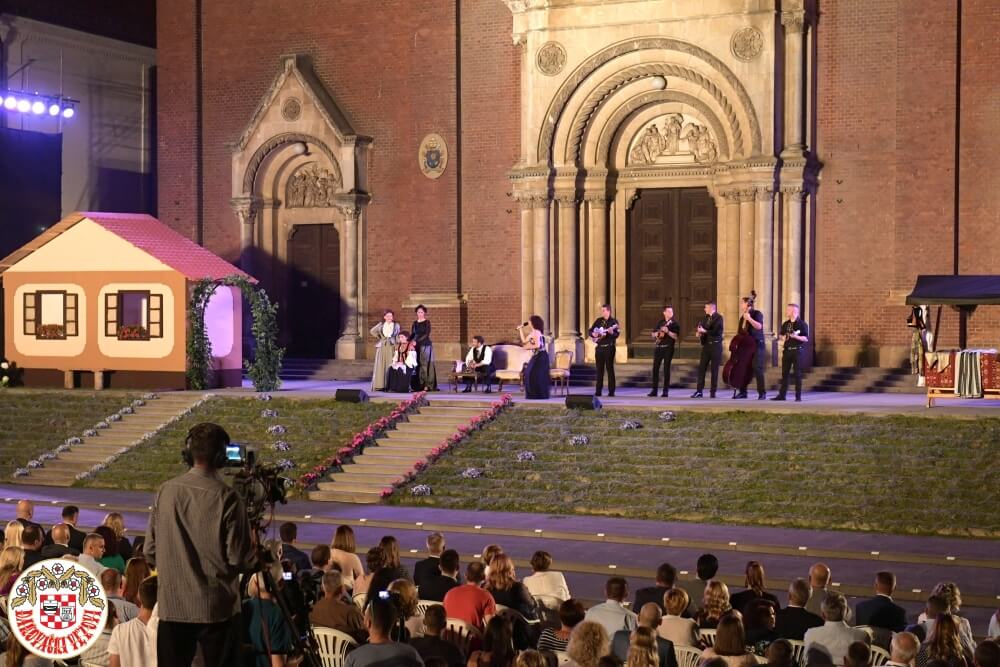
The opening of "Đakovački vezovi" in 2019 (photo credit: Photo Gallery - djakovacki-vezovi.hr)
Vinkovačke jeseni (Vinkovci Autumns) - Vinkovci
Definitely, the largest cultural event in the region, arguably in Croatia and some would say, in this part of Europe. The First Vinkovačke jeseni was organized in September 1966 and soon became one of the most famous festivals of its kind in all of Croatia. The foreground of the manifestation is the care of traditional folk dances, costumes, and customs in order to preserve various values of folk and traditional life of Slavonia. What’s really interesting is the fact that the manifestation is organized in September because of autumn - a season that rewards Slavonians for their hard work. After its founding, the festival soon began to connect all lovers of cultural heritage, not just Slavonia, but all the regions in Croatia. So every year hundreds of Folklore Societies from Croatia, Serbia, Bosnia and Herzegovina, Slovenia, and many more come to Vinkovci to display their culture to visitors. However, they didn’t stop there. Organizers recognized the tourist potential of their event and upgraded it for modern times, so apart from the main event which signifies a closure of Vinkovačke jeseni, the whole week before the opening is dedicated to its visitors! For instance, the opening of the event comes with a big performance by the local theatre with other guests from all over Croatia and in the evening the concerts of the biggest Croatian music stars begin, every evening of the week! Personally, I watched biggest Croatian performers on Vinkovačke jeseni stage like Dino Dvornik, Severina, Jelena Rozga, Klapa Intrade, Giuliano, Prljavo Kazalište and so many more. It truly is for everyone. Then, when the show of the manifestation ends on the last day of the week with the biggest folklore parade in this part of Europe (nationally televised), with the most popular folk and traditional commentator in Croatia, Branko Uvodić, every visitor feels enriched with Slavonian tradition, cultural heritage, food, art, folklore and more. That’s why Vinkovačke jeseni is one of the biggest traditional festivities in Slavonia and one of the best representatives of Croatian traditional, cultural heritage in this part of Europe. For more details, visit their official page. If you want to read more about Vinkovci, check this TCN article.
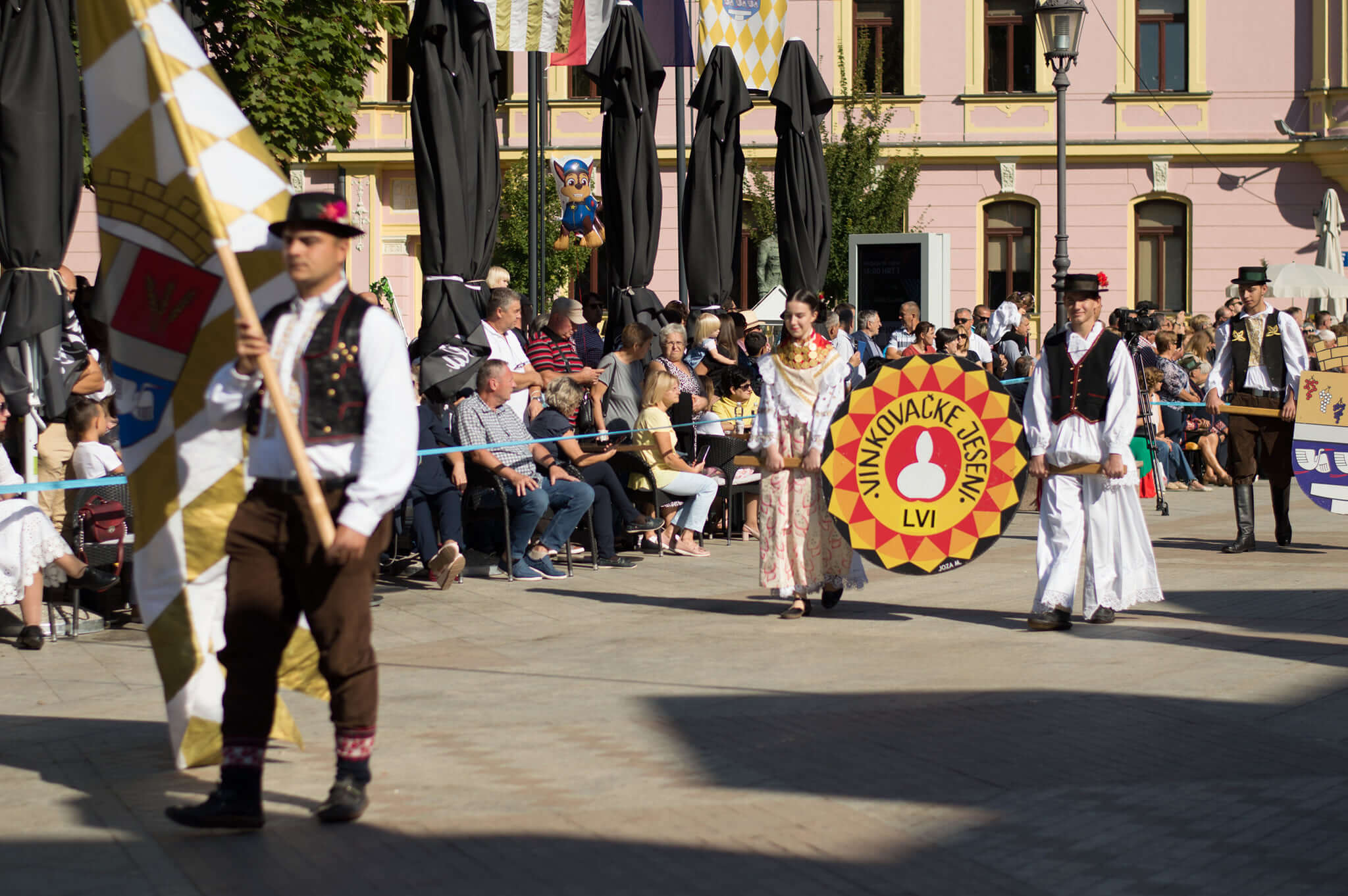
"Vinkovačke jeseni" parade - the main event on the last day (photo credit: Vinkovačke Jeseni - Facebook page)
Aurea Fest - Zlatne žice Slavonije (Golden Wires of Slavonia) - Požega
In the middle of Slavonia lies the city of Požega, located in the hilly parts of the region where none of the roads are straight - a place where hills are dotted with roads. Surrounded by the old hills of Psunj, Papuk, Krndija, Dilj, and Požeška Gora and home of the famous Croatian poet, Dobriša Cesarić, it doesn’t seem odd that this city is the home of one of the biggest traditional, cultural and musical events of folklore, tamburitza but also pop music, which has been held in Požega since 1969, with a break between 1981 and 1990. Zlatne žice Slavonije today is a four-day event with more than 40,000 visitors and more than 100 accredited journalists from several countries. Songs, top-tier wines, gastronomy events, concerts, exhibitions, art colonies, sports competitions, folklore festivals and other events are slowly making Požega and the Golden Valley one of the tourist destinations in Croatia in September. It hosted multiple Croatian musicians (mostly “tamburaši”) like Gazde, Zlatni Dukati, Miroslav Škoro, Slavonske lole and so many more. CDs and cassettes were pretty popular back in the day, which meant that almost every Slavonian household had a copy of musical repertoire from Golden Wires of Slavonia! So, if you visit Slavonia, definitely visit Požega in September - great content, songs, dances, food, and most importantly, people. The main event, the concert, is nationally televised on HRT every year. For more information, visit their official page.
For now, we’re stopping here. There are a lot of traditional festivities in Slavonia but these three events are staples of traditional festivities in Slavonia and the whole of Croatia. From entertainment to food and sports recreation, these manifestations are unmissable events if you want to visit Slavonia. Slavonian spirit cannot be recreated anywhere else, so if you want to relax further after a summer tour of the Adriatic, come to Slavonia, they’re going to welcome you with open arms.
For more, make sure to check out our travel section.
Planting Traditions in Slavonia: What Slavonians Like to Cultivate
4th of April 2022 - From Saint Patrick's Day, which is on March 17, Slavonians usually start planting crops for various reasons - for personal use, animals, and more. The planting season in Slavonia has thus begun, and we're taking a look at planting traditions in Slavonia.
Saint Patrick’s Day doesn’t hold particular importance in Croatia, except for the name day that people with a similar name celebrate. However, in Slavonia, this day marks the start of planting the crops that will be available for harvesting, and furthermore, some of those products will be stored for winter. Crops don’t have to necessarily be planted specifically on St. Patrick’s Day but after that date, people hurry to sow their plants before the rain. Why does it need to be done before the rain? For a simple reason - when rain occurs after sowing, the seeds will swell and the beginning of the growth process is in motion.
That is only the “first round” of the planting since not all plant crops can be immediately be planted. These next vegetables are most common in the “first round of planting”.
Potatoes
A useful vegetable that can be used in many ways and because of its flexibility and endurance during its growth, this plant is unavoidable in Slavonia. Potatoes from Lika are one of the most famous Croatian products. When planting, people make rows in their gardens that are approximately 25 centimeters deep and start putting potato tubers with sprouts, one by one, one foot away from each other (you can measure distance with your foot) and later buried with a hoe. Red and white potatoes are the most prominent ones and are planted for different uses - red potatoes are good for frying and roasting, and white ones are for boiling and cooking. People who don’t have big gardens or lands can also plant on their balconies or small spaces indented for planting.
Onion
Onions with potatoes are in the same tier of importance for Slavonians and have mostly the same attributes. Flexibility in its handling in the kitchen and mostly pretty endurable, this crop has many good uses. However, there is a problem that, of course, can be avoided. The danger of rotting is pretty common with this plant (which can be also said for potatoes but in smaller measure) and if not harvested on time, this is an unavoidable problem. Why? Well, when harvested, our ancestors would leave onions on the field to dry but with climate change and far harsher summers, they’re usually put under the canopy or whatever place where the sun isn’t blazing hot. Onions planted in March are usually ready for harvesting in July but even “young” onions are good for use, especially at Easter time.
Carrots and parsley
An indispensable part of any stew or soup, these two plants are really an important part of planting traditions in Slavonia. It is also harvested in July but has multiple uses besides its root. For instance, parsley’s leaves are put in the meals as a spice and it is present in almost every Slavonian meal - čobanac, gulaš, fiš, and many more. Carrots, on the other hand, can be consumed young as onions - roasted young carrots coated in butter equals a great summer meal. One more plant that can be cultivated in small and closed places.
Garlic
This plant has, so to say, a mythic reputation in multiple cultures including Slavonia. From having healing attributes for stomachaches, strengthening immunity, and so on, to flexible uses in the culinary world. If any ingredient symbolizes Slavonia, that’s definitely garlic - spicy, strong smell and certainly a food that enhances every meal. Planting is the same as is with onions - bulbs are put in the ground and just gently covered with soil. A very durable plant that can withstand any weather and be usable all year. It can be cultivated anywhere.
Celery
Its head is mostly used for meals but the culinary internet revolution discovered newfound use for its leaves. They can be put in the pesto, carbonara, or just a sauce ingredient for extra flavor. Celery heads in Slavonia are used as an ingredient for soups and stews like previously mentioned gulaš and paprikaš. It can be stored for later use and its durable ingredient is why this plant is part of cultivating and planting traditions in Slavonia. In recent years, it's also been used as a juice! Rich with sodium and vitamin A.
Red beet
Also planted in the first round of planting, red beet has multiple uses and is one of the healthiest ingredients on this list. Its juice is used in the fitness world for strengthening a person's fitness and body. Furthermore, it can lower blood pressure and increase blood flow. Rich with folic acid, manganese, potassium, vitamin C, magnesium, iron and so many more. Its root in Slavonia is used mostly for winter storage, namely, pickled in glass jars. “Soily” taste and beautiful color make this ingredient an important plant in the Slavonian region.
Peas and string beans
These two at first glance seem the same but they’re not. Even though they’re from the same family of plants (legume or pea family), they can be used in different ways. Stews are probably most common in Slavonia for peas but string beans can also be prepared in salads or roasted with other vegetables. Their issue is that they’re really sensitive and require nonstop care. A great ingredient for various meals.
Those vegetables are most commonly planted in the first spring planting, however, a bit later in the spring season, seeds are replaced by seedlings, young plants that have already sprouted from their seeds. These include tomatoes, cabbage, swiss chard, broccoli, peppers, jalapenos, cucumbers, and many more. Cultivating from there needs to be on a higher level since these plants require more care which means more water, fertilizers, and fluids that protect the plants from harmful organisms - parasites. What’s also important to note is the importance of these crops, used and pickled for winter storage. Most common are homemade tomato sauce, pickles, so-called hunting salad, pickled pepper, mild and spicy, and many more.
If we look deeper, planting traditions haven’t changed much in recent decades. Proven methods from our ancestors still work, are even better than the modern ones we encounter today, and still feed generations of people in these areas. Every region in Croatia has its own traditions and that’s what makes Croatia so rich - whenever you go, you can see how Croatian people survived the toughest times and managed to use its resources in the best possible ways. Earth and ground we walk on are still one of the rare things that never let Croatians down and that’s reflected in planting traditions in Slavonia.
For more, check out our dedicated lifestyle section.
Poetry As Preservation of Slavonian Cultural Heritage and Tradition
31st of March 2022 - Meet Željko Čuljak, whose poetry and stories about the beauty of Slavonia and its residents aim to preserve the cultural heritage and tradition of his village Cerić and the whole Slavonian region.
We spoke with Željko in his home in the small village of Cerić, which is located near Vinkovci and has suffered a tragic fate. During the Homeland War, Cerić fell and was destroyed to the ground - residents lost everything and inevitably fled the enemy aggression which destroyed everything in their way. Željko, with his fellow fighters and villagers, stayed behind and helped to protect Nuštar, a nearby village that resisted tireless enemy attacks and led bloody battles that lasted for days. On the 5th of October in 1991, just a few days after surrounding villages fell to the enemy hands (Cerić and Marinci), Croatian defenders resisted enemy attacks and, in the end, managed to protect the village from aggressors. This event is forever inscribed in the history books of the Homeland War as the “Battle of Nuštar”, which was one of the biggest wins of the Croatian army in an effort to protect the country of Croatia from aggressors. Why is this event mentioned? Because its consequences left a big scar on Cerić and its surroundings - destroyed homes, displacement of the residents, destroyed the most recognizable symbol of the village, the church and so much more. The identity of the village was shattered by those buildings and still has an impact on the village's atmosphere today. However, returnees to the village and new residents made it their mission to bring back the old glory of Cerić, promote how people lived before the war, and show that their tradition, cultural heritage, and their lives were not erased on that fateful day in 1991.
Thus, join us in meeting Željko, who is at forefront of the mini “Slavonian revolution” which is propelled by his stories and poetry about the past and present and the future of Slavonia as well.
Željko, can you tell TCN readers a bit about yourself?
My name is Željko Čuljak, a folk poet and a writer, a defender of the Homeland War and a retiree, who in their free time raises pigeons and writes stories about Cerić and Slavonia. I am a father of three children, a grandfather, and a husband. My writing is connected to the exile of our village, ten years of watching my village from the frontlines. To understand my writing and me in general, you need to see where I live.
What is Cerić? If you look at it as an outsider it seems like any ordinary Slavonian small village, so what is so special about it to you?
We live in Slavonia, a rich and “full” region that through time attracted a lot of conquerors and consequently, misfortunes. People who lived here suffered a lot during a few wars that happened in this region and after those casualties, the number of residents rapidly decreased which led to people all over the country migrating to Cerić. In the beginning, a lot of conflicts occurred between immigrants and the old residents, who felt threatened by the newcomers. However, after some time, harmony and love prevailed and connected these different groups. Love won in the end and those newcomers accepted the village's customs and cultural heritage and traditions of this region. In conclusion, calm people live here.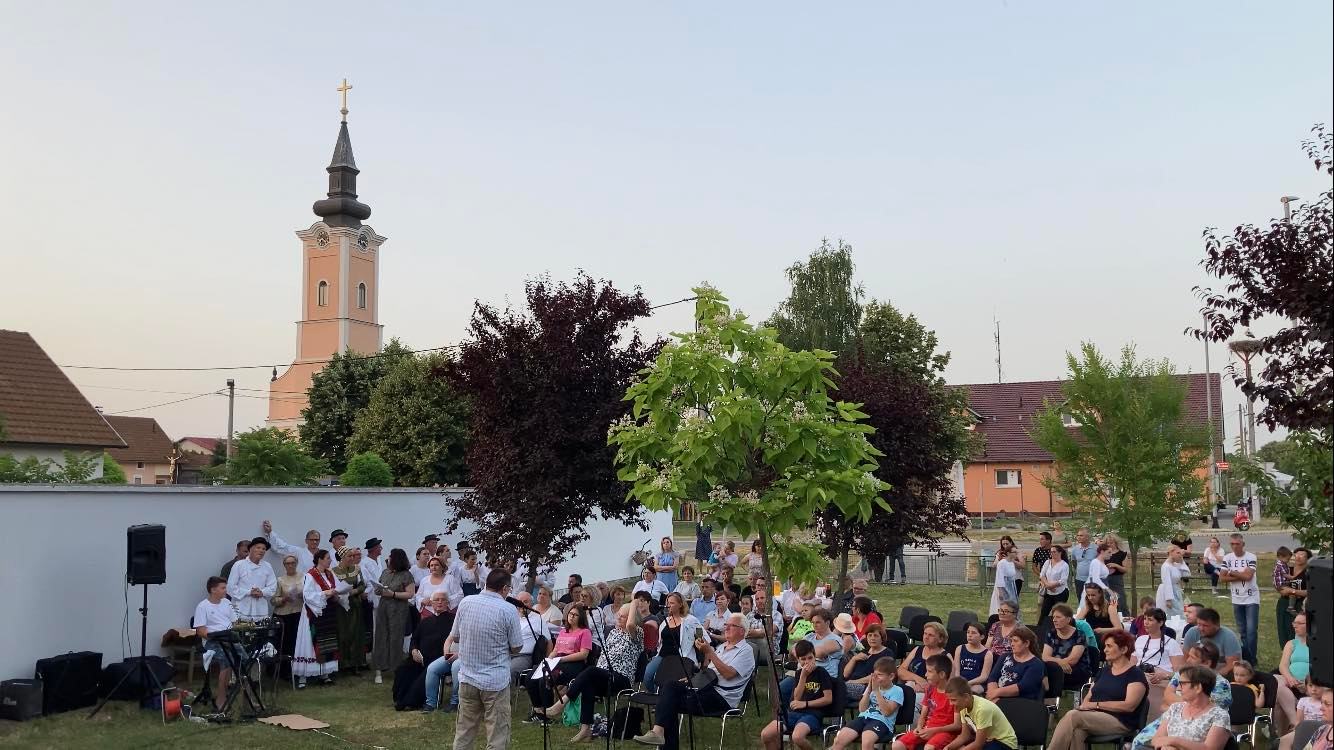
"Evenings with Poetry" in Cerić, (photo credit: Vedran Čuljak)
When did you discover your passion for writing?
I don’t talk much, a lot of the things I prefer keeping to myself and we were taught “if you don’t have anything nice to say, it’s better for you to be quiet.” I endured the war better while I was in it than when I came back to destroyed homes and a neglected village, it fuels the anger in you. That site slowly but surely built up anger and rage in me and I couldn’t express it to others nor me. Then, one time at the mass, I heard a priest talking about anger and saying: “Love your enemies, forgive!” How can I do that?! I realized that I need to forgive myself to let go of that anger. When I’m surrounded by so many good people, how can I be angry?! And those experiences fueled my inspiration for writing. Firstly, I started writing for myself. I write about the beauty and happy adventures of our lives and their residents. I felt sorrowful for not sharing my work with anyone, so I started gifting and selling my work to family and friends. When they liked and praised my work, I felt like I was doing something right. Also, I am part of the Folklore Society of Cerić "Slavko Mađar" and they always need new ideas or “old” ideas I realized that war kind of erased part of our history, people who “disappeared” from this place took the tradition and cultural heritage with them. Today, I’m sort of a keeper of memories in Cerić, one of the people who bring those old stories and memories back to residents and it, unfortunately, seems that people forgot most of them. I try my best to save and preserve that cultural heritage for children of the future. We have a very nice combination of us poets who write and the rest of the village who “absorb” everything we make. We give our poetry soul and actors from Folklore give them life.
Željko, do you think there are enough of these initiatives that have the mission of preserving and promoting Slavonian cultural heritage?
Folklore Societies are keepers of tradition and it’s well represented, not just in our region but throughout all of Croatia. Every village and town have their own Folklore Society. The question is, are people aware of them? Once upon a time, people were actually running away from tradition and it was an embarrassment to even be connected to these groups because everything else foreign was better. Then we realized during War that we miss sitting under the old mulberry tree while the spring sun is shining, harvesting our own crops and so many more things that make this region unique. Simply, all of the residents of Cerić realized that that’s the point - it’s nice to go abroad to a beautiful country or city but in the end, there is no place like home.
Do you have any of your original work published?
I have a collection of poems called Trace of The Soul (Trag Duše) which came out in 2019. It’s mostly poems about the war we experienced, adventures, and traditions Cerić offered and inspired me to write about. I wrote another book of poetry expected to be published near the end of the year, it should’ve been published before but COVID-19 slowed down the process. It’s easy to write for me since there’s a lot of inspiration around me like children going back from school, the boy who’s a head shorter than the girl but still carries her bag, and those kinds of stories make my writing worthwhile. Everything is simple and lively in this village.

Original cover of "Pattern of the Soul" (Trag duše), Željko's published work, (photo credit: Vedran Čuljak)
Who’s your biggest critic?
My wife is my eternal inspiration to me haha AND my biggest critic of course. Everything that works and everything that doesn’t work she always tells me. She knows how to read my poem better than I! I don’t know how to interpret it when I write it! To me, it’s a blessing and brings me a lot of joy when every poem finds its own role, every person finds themselves in my poem, my story. We are extremely lucky that our whole village participates with us.
Can you tell us the events or manifestations that you organize every year in your village?
We have “Evening of Poetry” which is usually held during summertime at the end of June. It’s part of the celebration of our saint of the village, Ivan (John), or how we say it here, Ivanje. Usually held in the evening, residents gather and light up the torches, we sit on bales of straw in the middle of Cerić and recite our poems and stories. Residents and our guests also participate in the event and it’s such a beautiful celebration of Slavonian cultural heritage and traditions. We have one more event, the “Yearly concert of Folklore Society” which is held around Municipality Day of Nuštar. Local people criticized this manifestation since it was held on 2nd of the October which was the day Cerić fell in the Homeland War. We were accused of celebrating the biggest tragedy this village experienced in its history. What they didn’t understand is that we always celebrate life, coming back to our homes, all of those people who were exiled or have left us for other reasons and we do it with songs, socializing, being happy and that’s the most important part.

One of the manifestations celebrating the cultural heritage of Cerić and Slavonia, (photo credit: Vedran Čuljak)
As we know, Slavonia lost a lot of its residents in recent years, do you think that factor will affect your manifestations?
I don’t think so. Residents of Cerić notice our work as our guests as well. For example, we had a group of school children coming to our village as part of their trip, it was some kind of Vinkovačke Jeseni program and let’s just say the children weren’t that positive coming here. Why? Because they didn’t know what Cerić is, never heard of it and of course, they’re just not interested in those places, what can Cerić offer to them? However, after we hosted them nicely, organized nice lunch, their teacher, who was in charge, told us that this is the first time in her career that the children didn’t want to go home, they didn’t want to enter the bus and go. I know it’s a small sample but everyone who comes here, goes back home happy and they come back every year. There is still interest and to me, it seems it’s growing in the last few years.
Does that mean that there are successors and willing children to continue doing what you started? Promoting and persevering Slavonian cultural heritage?
Definitely! More and more children realized villages' worth, their traditions, and cultural heritage. Cerić and its residents are unbelievably close and connected, while other villages talk about the alienation of their residents from their heritage, we prosper every year more and more. When a child puts on our traditional folk costume (šokačku nošnju) and when you look at the photos of their ancestors in the same costumes, those children are vivid pictures of their predecessors, great grandmothers, great grandfathers, only the hair and clothes changed. Everything stayed the same. There are successors and always will be. They will never disappear!
Thank you Željko for your time! Can you recite one of your original Slavonian poems for the TCN readers?
From the poem "Slavonia, Mother"
"When I leave my homeland at dawn
I carry in my eyes a memory far from
far from the eye, to the heart, it's also hard
I will return once through tears, I said
.....
We'll meet again under the old oak
when the years close my dreamy eyes
until then I love you and always think of you
in my dream, almost every night I dream about you."
Events celebrating Slavonian cultural heritage mentioned in this interview are held in Cerić on the 24th of June "Evenings with Poetry" and the 2nd of October "Yearly Concert of Folklore Society "Slavko Mađar". If you're ever close and for instance, ever come to "Vinkovačke Jeseni", visit Cerić and their events, Slavonia, as always will welcome you with open arms.
For more, check out Made in Croatia.
Carnival in Eastern Slavonia: February Masquerade Traditions (Part II) - The Food
February 23rd, 2022 - With every traditional festivity comes a reflection of our ancestors' lives, which ties closely to what they ate. This is part two of Carnival in Eastern Slavonia, but this time - the food edition. A look into what Slavonians eat during this traditional event.
Even though it was mentioned in the previous article that the roots of Carnival and Masquerade don’t have anything to do with Christianity and other religions, here in Eastern Slavonia, people decided to connect these traditions with Lent and Easter, which is usually a month and a half later in the Catholic calendar. Food is a significant identifier for every region in Croatia. For instance, Slavonia is popular for its heavy food: pork meat-based food like kulen, its “sister” seka, cracklings (čvarci), sausages, and stews made from beans, cabbage, and many more. Other homemade products are jams made from plums, quinces, apricots, and whatever fruits are available during the summer season. Furthermore, those jams are stored in cold pantries and can last for more than a year if it’s preserved and packed correctly. All mentioned dishes and products are consumed during winter until another set of preparations - always scheduled simultaneously and dated.
In February, these “heavy” dishes, especially dried meat ones like cracklings, are usually used for baked delicacies like čvarnjače, which are made so the leftover cracklings are not thrown away. They are made of salty leavened dough made out of fine flour with grounded cracklings (made out of melted lard) and can be eaten with sour cream or yogurt.
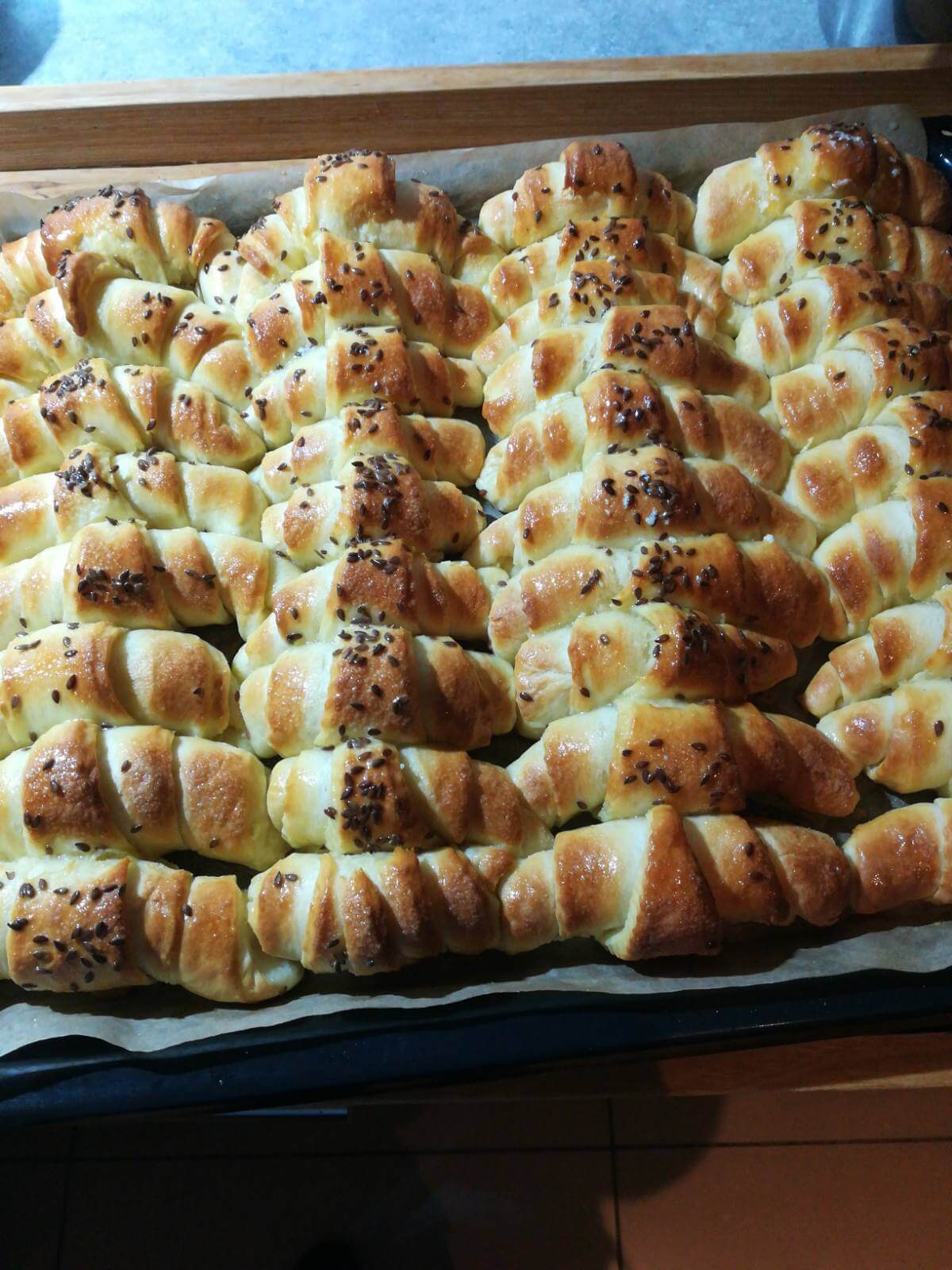
My aunts rolls - "kiflice," Private album
Rolls (kiflice) are also made from salty, leavened dough. Before putting them into the oven, they’re coated with eggs or milk for the colour and sprinkled with sesame or cumin. Since rolls are usually served empty as a snack, Slavonians eat them with a plate of dry meat like kulen, ham, and sausages. It can also be eaten with dairies. My personal favourite is when they are filled with ham and cheese.
Now we get to the good stuff. Sweet delicacies.
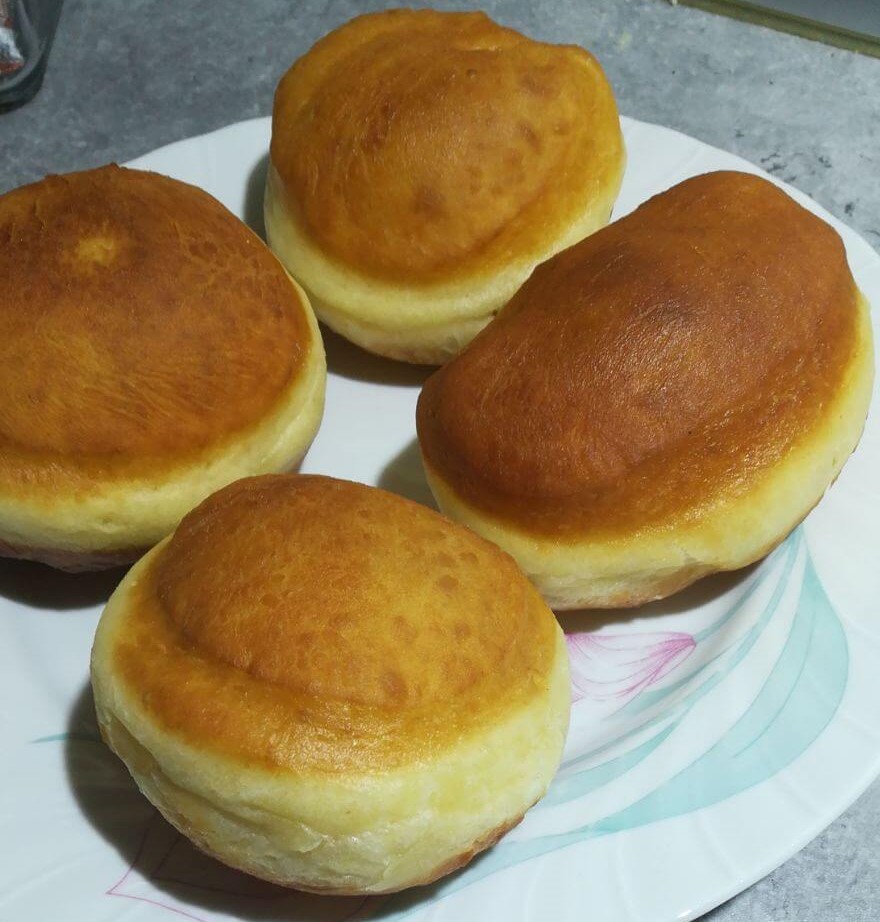
My aunts "krofne" , Private album
During carnival and masquerade in February, the most popular sweet food is donuts (krofne). It is a German sweet dessert made of leavened pastry, baked primarily in hot fat in these parts of the country or oil. In Slavonia, these donuts are called “krofne,” which is a distorted name from the German word “krapfen,” whereas in northern parts like Zagreb and the region of Zagorje, they’re called “krafne”. Interestingly, they’re not usually baked very often, only on special occasions, like “svinjokolja” (pig slaughter), New Year’s, and of course, Carnival. Furthermore, our ancestors believed that “krofne,” while being cooked and rising in volume, symbolizes grace in every aspect of life. Nevertheless, “krofne” are still very prominent in the lives of Slavonians, and they’re usually eaten with powdered sugar and homemade jams. Newer versions of “krofne” come with Nutella and other chocolate spreads, which are very popular with children.
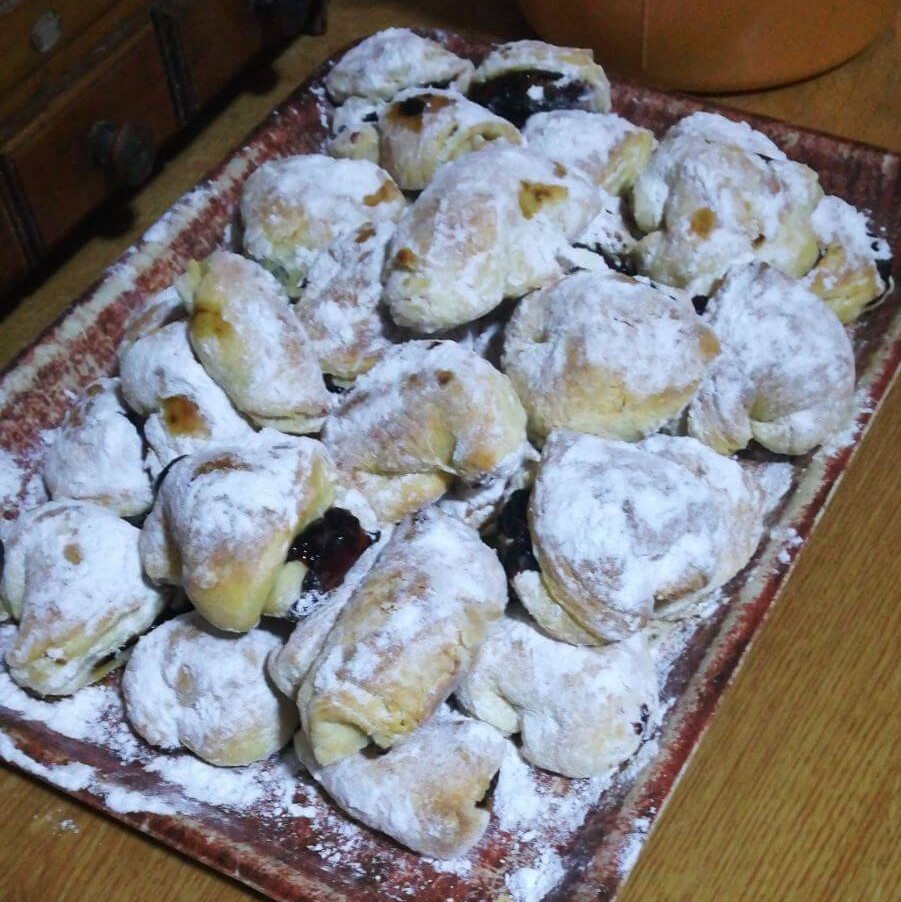
My aunts "salednjaci" - puff pastry dessert with homemade jam, traditional Slavonian delicacy, Private album
This sweet delicacy is a typical traditional Slavonian dessert prepared during “svinjokolja” and the Carnival - “salednjaci.” The name varies in other regions in Croatia; for example, in Zagreb and Zagorje, it is called “salenjaci.” Butter is a usual ingredient for puff pastry, but mothers and grandmothers would use pig lard because there would be a lot of it left after pig slaughter. Also, butter was costly back in the day, so people had to find ways to make those desserts. This delicacy is known as “Croatian croissants with character” and “a cake with thousand leaves” since the puff pastry is folded four times during the process. They’re usually filled with homemade blue plum or an apricot jam. Unfortunately, people have reservations about this dessert because of a misconception that pig fat or lard are not healthy.
On the contrary, it’s healthier than most of the ingredients we consume today. The dessert got lost in the last two decades or so, but it’s slowly coming back through the effort of institutions that preserve tradition and women who started bringing out this dessert on special occasions. Of course, that includes traditional events and festivities in Slavonia during wintertime.
Furthermore, sweet cakes and pastries like “mađarica,” “bijela pita,” “medena pita,” and more are also included on this list. Still, it would take a few more articles to name all traditional Slavonian food.
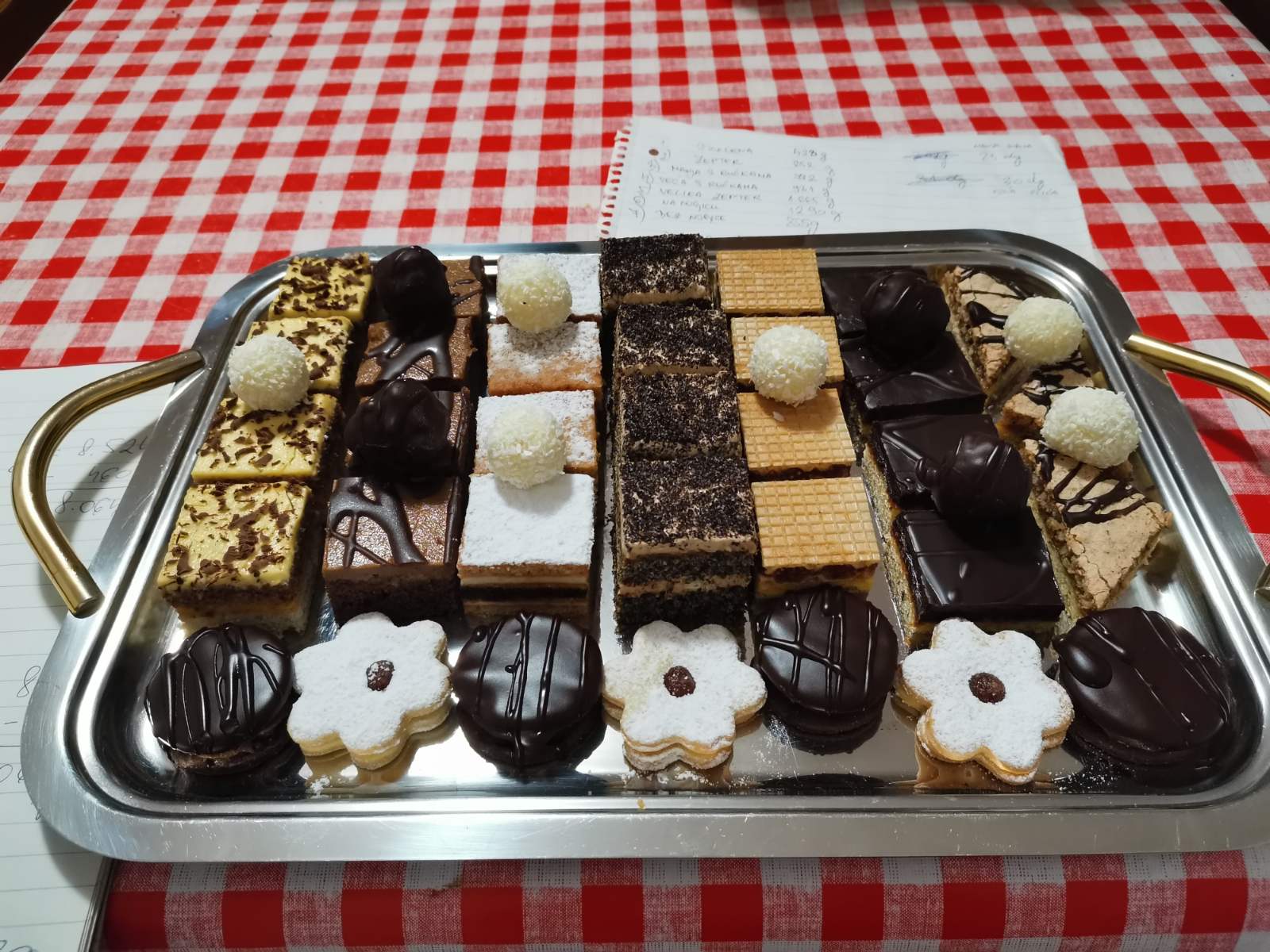
My mother's sweet cakes and pastries, usually made during winter times, Private album
In the end, this article can also be used as an invitation for you to come to Slavonia and participate in the Carnival and other festivities to try these rich delicacies that fed generations and generations of people and still do. There are seven days left until Lent, so hurry up and experience the rich Slavonian life because if there’s one thing Slavonians know how to do, it is eating rich and enjoying life.
For more, check out our lifestyle section.
Carnival in Eastern Slavonia: An Intro to February Masquerade Traditions (Part I)
February 16th, 2022 - In Croatia, after Christmas and New Year's, February is usually reserved for the Carnival, which is tightly connected with the Masquerade tradition that leads to the Carnival as an intro to Lent and later, to Easter. Each region has its own tradition that has been maintained for centuries. A look into Carnival in Eastern Slavonia.
The Carnival (Poklade) is a calendar custom between the Epiphany (January 6) and Lent (Korizma). It is marked by masked processions and parties, merriment, madness and debauchery, and an abundance of food and drink. The highlight of the event is the last Sunday, Monday, and Tuesday (Shrove Tuesday) before Ash Wednesday. Its roots don’t have anything related to Christianity - primarily of magical, apotropaic significance. Any disguise, clothes worn on the wrong side, deafening noise, pouring ashes, and more, should drive away the winter, demons, and evil forces that repel their actions from people, livestock, homes, and crops. Carnival events in the Croatian folklore tradition can be divided into two main types. One type is referred to as lupercal; they are seemingly more archaic, common in the rural and livestock areas. Participants are groups of men dressed in animal skins, with bells hung on their bodies or worn on their hands. The second type of carnival event in Croatia is saturnal; they occur in cities, particularly common on the Adriatic coast and island areas. These usually contain less magical features and are more focused on entertainment and social criticism. As mentioned before, even though the event overlaps with Christian holidays, the Catholic Church has been trying to suppress these traditions for centuries because of the opposing nature to every existing authority throughout history.

Photo credit: Marko Miličević - načelnik Općine Ivankovo
The Eastern Slavonian Carnival is used for the hedonistic type of “partying” before Lent - a time for mourning, renunciation, and penance. Every village has its own day for organizing the Carnival, it all depends on when Lent starts. Carnival time starts with Masquerade (Maškare), more precisely, the procession of rural masquerades with participants disguising themselves in various characters. Men are mostly dressed as women and women are dressed as men. Masked groups visit every house in the village and sing in front of them for gifts like sweets, food, and drinks. After that, “masqueraders” thank the hosts and continue their journey through the village looking for more gifts. However, in the 2000s, these masked groups became groups of children who would go on tour all over the village after school, singing and seeking gifts from villagers. If a host doesn’t react to the singing of masked children and doesn’t come out of the house, houses get “attacked” by rotten eggs. This tradition probably came into relevancy in the last 20 years or so because it is impossible to find a legit source about it and it is not a really pleasant experience, especially if you need to clean rotten eggs off the walls of your house.
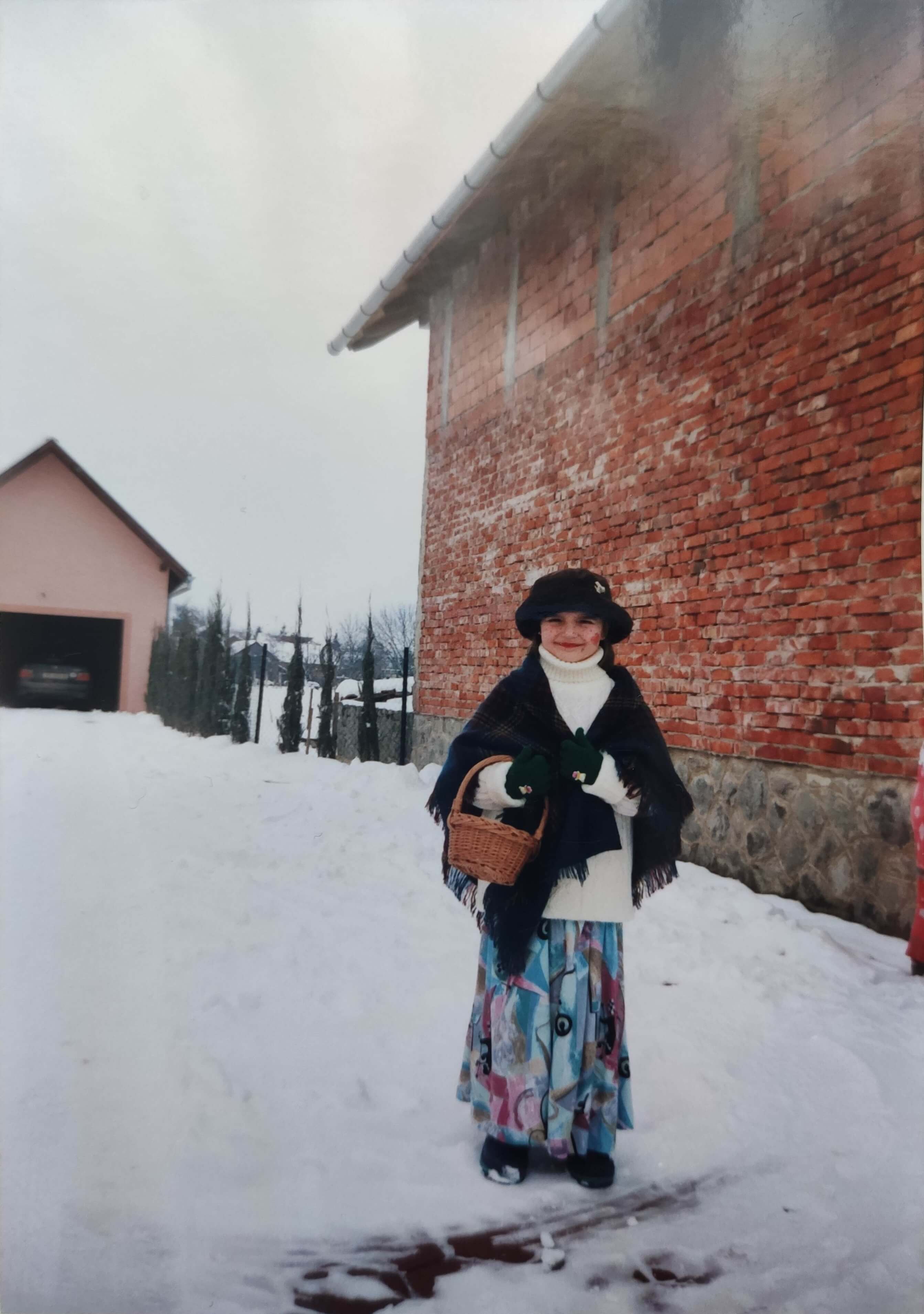
My sister ready for masquerade with her friends, at the beginning of 2000s - Private album
A huge part of the Carnival in Slavonia is the so-called Carnival riding (Pokladno jahanje) which is a tradition that goes back all the way back to the 18th century. Carnival riding came to prominence during Military Frontier (Vojna Krajina) and some Slavonian villages maintained it until after Second World War. The custom was revived after the Homeland War and again became one of the most important events in Slavonia. Riding through the village, the riders would stop at houses of certain families who treated them with Slavonian food and drinks and they usually repay them with a song. After leaving the host's house, the horsemen would sing “Domaćine, od srca ti hvala, što nam tvoja desna ruka dala” (Thank you, hosts, thank you from the bottom of our hearts, what your right hand has given us”). This type of celebration is still going strong and has more and more riders every year, in an effort to preserve the tradition and identity of Slavonia. What is also characteristic of this Carnival is that in some places in Slavonia masked plowmen come with the plow to plow village streets or yards and for that job they get rewarded with sausages, sweet cakes, and donuts (in Eastern Slavonian slang “krofne”) by hosts.
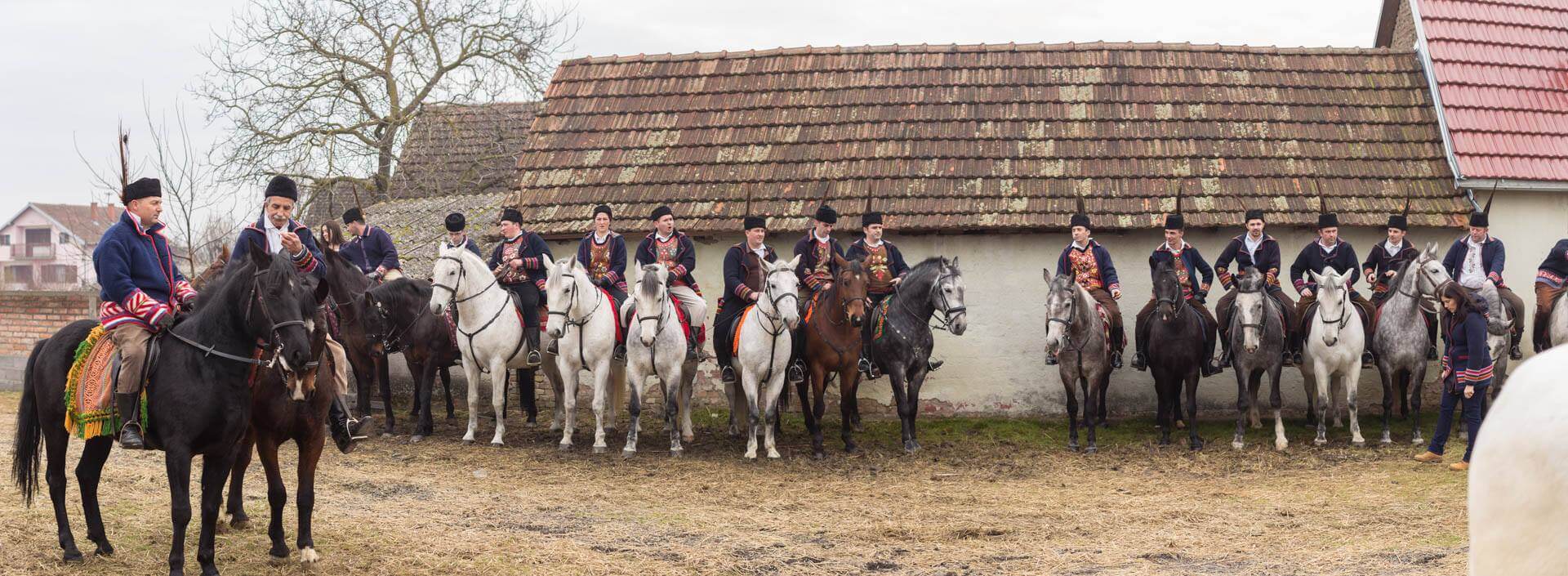
Horsemen getting ready to start their tour through the village - Photo Credit: Marko Miličević - načelnik Opčine Ivankovo, Facebook page
This event, as mentioned before, is an intro to Lent and lastly Easter. Apart from organized games and parties, Carnival is also a great place to introduce the traditional food and drinks Slavonia has to offer. However, that needs its own article. Until next time.
For more, check out our lifestyle section.
Ivo Pilar Social Research Institute Expanding Scientific Cooperation in Sarajevo (BiH)
July 2, 2021 - Dedication to researching and developing the field of social sciences sees the Ivo Pilar Social Research Institute expanding scientific cooperation once again after Željko Holjevac's visit to Sarajevo, in Bosnia and Herzegovina.
The Ivo Pilar Social Research Institute, active as always, continues to expand its cooperation on scientifically explain social issues (symbolically noted as 2021 marks 30 years of the Institute).
As reported on their official website, Institute headmaster dr. Željko Holjevac visited Sarajevo, the capital city of the neighboring Bosnia and Herzegovina, from June 21-23.
The main story of that visit was a signed bilateral cooperation agreement between the Ivo Pilar Social Research Institute and the Sarajevo Catholic Faculty. The agreement was signed by Holjevac and Faculty dean dr. Darko Tomašević.
Additionally, Holjevac was at the reception with Vrhbosanski's vice bishop Vinko Puljić.
„They talked about possible shared projects that would be adjusted to the tradition, culture and developing needs of Croats in Bosnia and Herzegovina“, informed Ivo pilar social research Institute.
Croatian Cultural Society Napredak (progress) also met with Holjevac. Napredak soon celebrates 120 years of work and was founded at the start of the 20th century when the famous Croatian social scientist Pilar was active in Bosnia and Herzegovina. Napredak plans various manifestations for their big anniversary, and dr. Holjevac discussed the possible cooperation in organizing an international scientific symposium regarding the identity of Croats in Bosnia and Herzegovina.
Ivo Pilar Institute working in full speed
This sort of cooperation in regards to researching the Croatian diaspora in the neighboring country where the Croatian historical role and present is significant is nothing new for the Ivo Pilar Social research Institute.
As TCN reported earlier in May, the Institute, along with scientific partners, organized a conference “Identity of Boka Kotorska Croatians“, and the three-day event gathered crucial scientific institutes in Croatia to the town of Tivat in the Bay of Croatian Saints in Montenegro.
Scientists from the Institute were also active this year as they participated at European Conference For Social Work Research (ECSWR), International Society for Ethnology and Folklore (SIEF) Conference, and also by presenting a book on Croatian Mountain Rescue Service in Gospić, or by presenting book Cultural Identity of Vukovar – Contribution to Investigating Heritage and Successors“ – to list some of the activities TCN reported on throughout 2021.
As 2021 marks the 30th year anniversary of the Ivo Pilar Institute, apart from the aforementioned actions (to which we can include nurturing relations with scientific colleagues in Slovakia or opening a new research office on Vis Island), several more goals were envisioned by the end of the year: to publish the first edition of critical translation for the book „South Slavic (Yugoslav) Question“ by Ivo Pilar from 1918, and to make and publish Pilar's Kaleidoskop of Croatian society.
With the active academic dynamic demonstrated by the Institute, there is no doubt there is enough quality and capacity to achieve these goals. It is only a matter of time in such a busy and productive schedule.
Learn more about Croatian Diaspora on our TC page.
For more about science in Croatia, follow TCN's dedicated page.
First Croatian Olive Oil for Children - Brachia Kids
There's no denying that Croatian olive oil is second to none, and we're not the only ones who think it. Croatian produce has won award after award and the long coastal traditions of olive growing, picking and harvesting in Croatia are worthy of just as much praise as the final results of that hard work are.
As Morski writes on thr 4th of April, 2019, the respected Brač brand of olive oil, Brachia, has launched Brachia Kids, the first Croatian olive oil made just for children of kindergarten and elementary school age, reports Journal.hr.
''Brachia Kids brings the fresh and intriguing taste of organic olive cultivation from ecological [olive] growing from the island of Brač. These flavours are ideal for children when it comes to falling in love with the taste of olive oil. This new product is intended for parents who understand the healing properties and the great nutritional value(s) of olive oil, and who want to introduce it to their children's diet,'' said Leopold Botteri, the co-manager of the Brachia cooperative.
Part of the main role in popularising the consumption of olive oil for children will also be played by its attractive packaging, which has been made by Izvorka Jurić and Jurica Kos.
''We've designed the packaging so that the product is attractive to children, fun to use, and also educational, in order to develop their awareness of the importance of the regular use of olive oil. The body of a glass vial (0.25 dcl) has been partially placed in a box that, together with the black tip of the bottle, forms a crayon, and within which six crayons are actually housed. Following the dissolution of the box, there is a fun colouring book with illustrations of olive trees and leaves and various tasks for children to complete. Olive oil nourishes the body, and the puzzle and colouring on the packaging, acts as food for the brain. Together, they make a complete product for the healthy development of children,'' explained packaging designer Izvorka Jurić.
In addition to the premium olive oil of Brachia Maslina and the latest Brachia Kids product - Izvorka Jurić has designed products for the lines of Brachia sort oils, ecoBrachia and Brachia & Friends. All of these products, including Brachia Kids' olive oil for children, are now available for purchase in UJE stores across the Republic of Croatia.
Make sure to follow our dedicated Made in Croatia page for much more.
Dalmatian Students to Uphold Klapa Traditions in Zagreb
Far from the calm yet rugged shores of Dalmatia in the Croatian capital of Zagreb, Dalmatian students are set to showcase Dalmatia's rich history with traditional klapa singing at the seventh student klapa festival.
As Gordana Igrec/Morski writes on the 16th of March, 2019, Klapa music can be heard up and down the Dalmatian coast and is an intrisic part of Dalmatian culture. From Dubrovnik and the extreme south of Dalmatia up to northern Dalmatia, many different groups exist from area to area and from city to city.
The word klapa means ''group of friends'' and this type of a cappella singing, which focuses mainly on romance and love, as well as on the sea and various parts of Dalmatia, traces its long roots back to littoral church singing.
The seventh festival of student klapa organised by the Split students' association will be held on March the 23rd, 2019, at the Student Center in Zagreb (Studentski centar, Savska 25), starting at 20:30.
For the seventh year in a row, the festival offers students the opportunity to be part of a traditional and cultural event which works to present the richness of Dalmatian musical heritage to the public and to continental Croatia. All those interested in this type of music are invited to come and showcase their talents and present Zagreb with one of the most influential and recognisable symbols of Dalmatia - klapa singing. There's still time to register.
When one walks the usually busy streets of the very central European City of Zagreb, the sights and sounds of Dalmatia appear a world away. Owing to this festival, the capital will become a hub for the sounds of the city's resident Dalmatian youth, as it has been in previous years.
In this way, Dalmatian students are able to freely continue to cultivate their klapa singing traditions and their culture away from their coastal homes, and further enrich the continental Croatian City of Zagreb, where they have come to study and work, and where many will remain permanently.
Make sure to follow our dedicated lifestyle page for much more. If it's just Zagreb you're interested in, give Total Zagreb a follow.
Click here for the original article by Gordana Igrec for Morski


